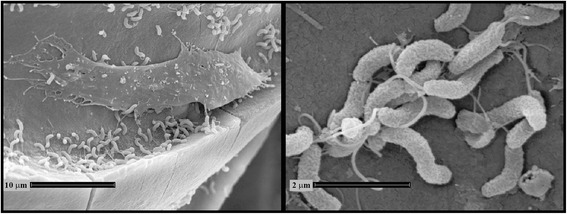Fig. 1.

Scanning electron microscopy of V. anguillarum NB10 attached to a scale from an infected rainbow trout. The left image was taken at a 3,500× magnification and shows that the bacterium colonizes the groove of a growth ring. A highly motile skin epithelial cell called a keratocyte is shown above the growth ring and V. anguillarum evades internalization by the keratocytes [51]. The right image is a higher magnification (20,500×) of V. anguillarum cells attached to the surface of the fish scale. In this image, the curved, rod-shape of the bacterium is visible as well as the single polar flagellum. To obtain samples, rainbow trout, 15 g in weight, were infected with V. anguillarum NB10 via bathing in infected seawater. At 48 h post-infection at 22 °C, scales were removed from lesions that formed on the skin, washed 3× in phosphate buffered saline, and fixed in 2.5 % gluteraldehyde. Electron micrographs were taken using a Cambridge Stereoscan 360 iXP scanning electron microscope at the Electron Microscopy Platform at the Umeå University Core Facility for Electron Microscopy
